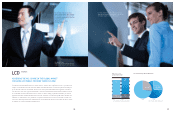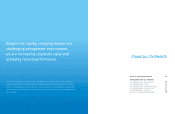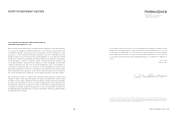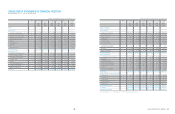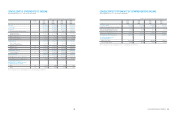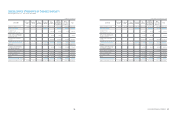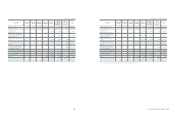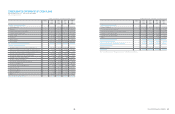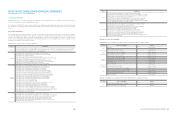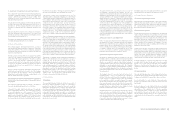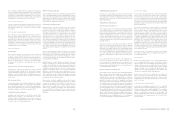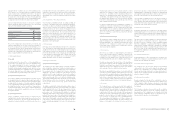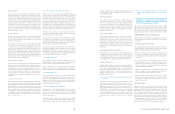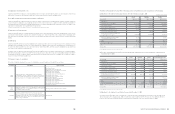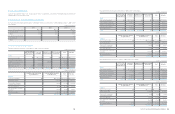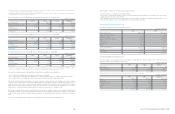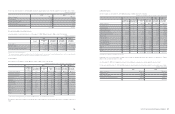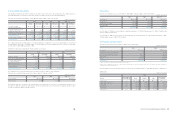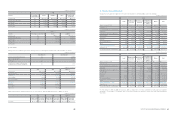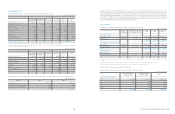Samsung 2010 Annual Report Download - page 23
Download and view the complete annual report
Please find page 23 of the 2010 Samsung annual report below. You can navigate through the pages in the report by either clicking on the pages listed below, or by using the keyword search tool below to find specific information within the annual report.42 43
NOTES TO THE CONSOLIDATED FINANCIAL STATEMENTS
2. Summary of Significant Accounting Policies
The Company first adopted the International Financial Reporting
Standards as adopted by Republic of Korea (“Korean IFRS”) from
January 1, 2010 (the date of transition: January 1, 2009). These
standards have been consistently applied to 2009 comparative
financial information presented.
The principles used in the preparation of these financial statements
are based on Korean IFRS and interpretations effective as of
December 31, 2010 or standards that will be enforceable after
December 31, 2010 but which the Company has decided to early
adopt.
Principal adjustments made by the Company in restating its
previously published financial statements in accordance with
generally accepted accounting principle in the Republic of Korea
(“Korean GAAP”) are described in Note 3.
The principal accounting policies applied in the preparation of these
consolidated financial statements are set out below:
2.1 Basis of Presentation
The Company prepares its financial statements in accordance
with International Financial Reporting Standards as adopted by
Korea (“Korean IFRS”). These are those standards, subsequent
amendments and related interpretations issued by the IASB that
have been adopted by Korea.
First-time adoption of Korean IFRS is set out under Korean IFRS
1101, First-time Adoption of International Financial Reporting.
Korean IFRS 1101 requires application of the same accounting
policies to the opening statement of financial position and for
the periods when the first comparative financial statements
are disclosed. In addition, mandatory exceptions and optional
exemptions which have been applied by the Company are
described in Note 3.
There are a number of standards, amendments and interpretations,
which have been issued but not yet come into effect. The Company
does not expect that the adoption of these new standards,
interpretations and amendments will have a material impact on the
financial condition and results of operations.
New standards, amendments and interpretations issued but not
effective for the financial year beginning 1 January 2010 and not
early adopted.
The Company’s and parent entity’s assessment of the impact of
these new standards and interpretations is set out below.
‘Revised IAS 24 (revised), ‘Related party disclosures’. It supersedes
IAS 24, ‘Related party disclosures’ . IAS 24 (revised) is mandatory
for periods beginning on or after January 1, 2011. Earlier
application, in whole or in part, is permitted. The Company will
apply the revised standard from January 1, 2011. When the revised
standard is applied, the Company and the parent will need to
disclose any transactions between its subsidiaries and its associates.
It is, therefore, not possible at this stage to disclose the impact, if
any, of the revised standard on the related party disclosures.
‘Classification of rights issues’ (amendment to IAS 32). The
amendment applies to annual periods beginning on or after February
1, 2010. Earlier application is permitted. The amendment addresses
the accounting for rights issues that are denominated in a currency
other than the functional currency of the issuer. Provided certain
conditions are met, such rights issues are now classified as
equity regardless of the currency in which the exercise price is
denominated. Previously, these issues had to be accounted for
as derivative liabilities. The amendment applies retrospectively in
accordance with IAS 8 ‘Accounting policies, changes in accounting
estimates and errors’. The Company will apply the amended
standard from January 1, 2011. It is not expected to have any
impact on the Company or the parent entity’s financial statements.
‘IFRIC 19, ‘Extinguishing financial liabilities with equity instruments’.
The interpretation clarifies the accounting by an entity when the
terms of a financial liability are renegotiated and result in the entity
issuing equity instruments to a creditor of the entity to extinguish
all or part of the financial liability (debt for equity swap). It requires a
gain or loss to be recognized in profit or loss, which is measured as
the difference between the carrying amount of the financial liability
and the fair value of the equity instruments issued. If the fair value
of the equity instruments issued cannot be reliably measured, the
equity instruments should be measured to reflect the fair value
of the financial liability extinguished. The Company will apply the
interpretation from January 1, 2011. It is not expected to have any
impact on the Company or the parent entity’s financial statements.
‘Prepayments of a minimum funding requirement’ (amendments to
IFRIC 14). The amendments correct an unintended consequence
of IFRIC 14, ‘IAS 19-The limit on a defined benefit asset,
minimum funding requirements and their interaction’. Without the
amendments, entities are not permitted to recognize as an asset
some voluntary prepayments for minimum funding contributions.
This was not intended when IFRIC 14 was issued, and the
amendments correct this. The amendments are effective for annual
periods beginning January 1, 2011. The Company will apply these
amendments for the financial reporting period commencing on
January 1, 2011. It is not expected to have any impact on the
Company or the parent entity’s financial statements.
2.2 Consolidation
1) Subsidiaries
The consolidated financial statements include the accounts of
SEC and its controlled subsidiaries. Control over a subsidiary is
presumed to exist when the Company has the power to govern the
financial and operating policies of an entity to obtain benefits from
its activities generally accompanying a shareholding of more than
one half of the voting rights. The existence and effects of potential
voting rights that are currently exercisable or convertible are
considered in determining whether the Company controls another
entity. Subsidiaries are fully consolidated from the date when control
is transferred to the Company and de-consolidated from the date
which control ceases to exist.
The purchase method of accounting is used to account for
the acquisition of subsidiaries by the Company. The cost of an
acquisition is measured at the fair value of the assets given, equity
instruments issued and liabilities incurred or assumed at the date of
exchange. Identifiable assets acquired and liabilities and contingent
liabilities assumed in a business combination are measured initially
at their fair values at the acquisition date, irrespective of the extent
of any non-controlling interest. The excess of the cost of acquisition
over the fair value of the Company’s share of the identifiable net
assets acquired is recorded as goodwill. If the cost of acquisition is
less than the fair value of the net assets of the subsidiary acquired,
the difference is recognized directly in the statement of income. All
inter-company transactions and balances are eliminated as part
of the consolidation process. For each business combination, the
Company shall measure any non-controlling interest in the acquiree
at the non-controlling interest’s proportionate share of the acquiree’s
identifiable net assets.
2) Transactions and non-controlling interests
Profit or loss and each component of other comprehensive income
are attributed to the owners of the parent and to the non-controlling
interests. Total comprehensive income is attributed to the owners of
the parent and to the non-controlling interests even if this results in
the non-controlling interests having a deficit balance. And changes
in a parent's ownership interest in a subsidiary that do not result
in a loss of control are accounted for as equity transactions (i.e.
transactions among owners in their capacity as owners).
3) Associated companies and joint ventures
Investments in companies in which the Company does not have
the ability to directly or indirectly control the financial and operating
decisions, but does possess the ability to exercise significant
influence, are accounted for using the equity method. Generally, it
is presumed that if at least 20% of the voting stock and potential
voting rights is owned, significant influence exists. The Company’s
investment in associates includes goodwill identified on acquisition,
net of any accumulated impairment loss. Investments in companies
in which the Company has joint control are also accounted for using
the equity method.
The Company’s share of its associates’ and joint ventures’ post-
acquisition profits or losses is recognized in the consolidated
statement of income, and its share of post-acquisition movements
in other reserves is recognized in other reserves. The cumulative
post-acquisition movements are adjusted against the carrying
amount of the investment. When the Company’s share of losses
in an associate equals or exceeds its interest in the associate,
including any other unsecured receivables, the Company does not
recognize further losses, unless it has incurred obligations or made
payments on behalf of the associate or joint venture.
Unrealized gains and loss on transactions between the Company
and its associates are eliminated to the extent of the parent
company’s interest in the associates and joint ventures. Unrealized
losses are also eliminated unless the transaction provides evidence
of an impairment of the asset transferred. Accounting policies
of associates have been changed where necessary to ensure
consistency with the policies adopted by the group.
Any dilution gains and losses arising in investments in associates
and joint ventures are recognized in the statement of income.
2.3 Foreign Currency Translation
1) Functional and presentation currency
Items included in the financial statements of each of the Company’s
entities are measured using the currency of the primary economic
environment in which an entity operates (‘the functional currency’).
The consolidated financial statements are presented in Korean
Won, which is the SEC’s functional currency.
2) Transactions and balances
Foreign currency transactions are translated into the functional
currency using the exchange rates prevailing at the dates of the
transactions or valuation where items are remeasured. Foreign
exchange gains and losses resulting from the settlement of such
transactions and from the translation at the exchange rate at the
end of the reporting period of monetary assets denominated in
foreign currencies are recognized in the statement of income,
except when deferred in equity as qualifying cash flow hedges and
qualifying net investment hedges.
Changes in the fair value of monetary securities denominated in
foreign currency classified as available-for-sale financial assets are
analyzed between translation differences resulting from changes in
the amortized cost of the security and other changes in the carrying
amount of the security. Translation differences related to changes in
amortized cost are recognized in profit or loss, and other changes in
carrying amount are recognized in other comprehensive income.
Translation differences on non-monetary financial assets such
as equities held at fair value through profit or loss are recognized
in profit or loss as part of the fair value gain or loss. Translation
differences on non-monetary financial assets such as equities
classified as available-for-sale are included in other comprehensive
income.
3) Foreign subsidiaries
The results and financial position of all the foreign entities that have
a functional currency different from the presentation currency of the
Company are translated into the presentation currency as follows:
Assets and liabilities for each statement of financial position
presented are translated at the closing rate at the end of the
reporting date.
Income and expenses for each statement of income are translated
at average exchange rates, unless this average is not a reasonable
approximation of the cumulative effect of the rates prevailing
on the transaction dates, in which case income and expenses
are translated at the rate on the dates of the transactions;
and all resulting exchange differences are recognized in other
comprehensive income and presented as a separate component of
equity.



